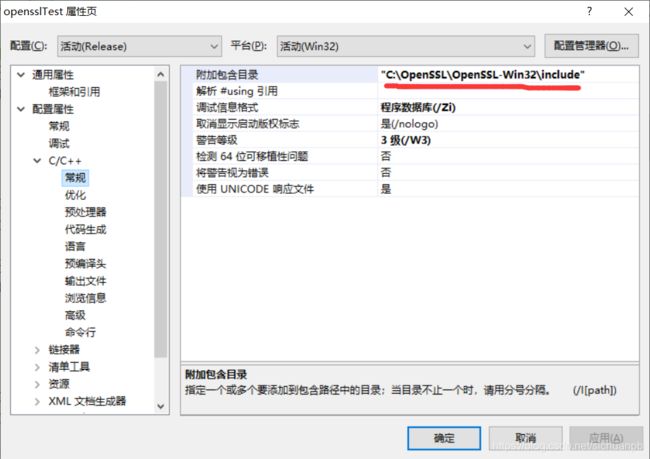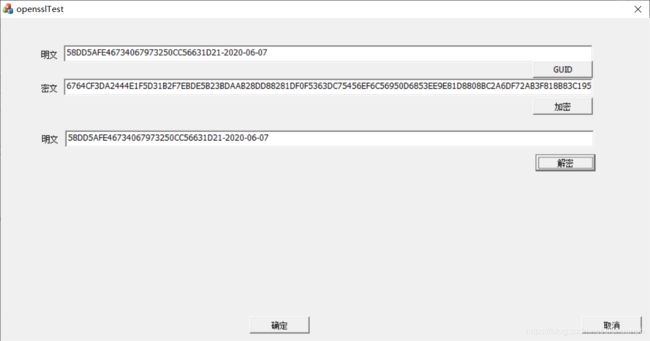OpenSSL的使用
SSL是Secure Sockets Layer(安全套接层协议)的缩写。OpenSSL整个软件包大概可以分成三个主要的功能部分:SSL协议库、应用程序以及密码算法库。OpenSSL的目录结构自然也是围绕这三个功能部分进行规划的。
作为一个基于密码学的安全开发包,OpenSSL提供的功能相当强大和全面,囊括了主要的密码算法、常用的密钥和证书封装管理功能以及SSL协议,并提供了丰富的应用程序供测试或其它目的使用。
首先是OpenSSL的配置
1 使用 WxpRsaLic::generateRSAKey(); 产生公钥文件pubkey.pem和私钥文件prikey.pem,
2 然后使用公钥加密数据,并把数据写入文件
string www;
CString strMfc("");
GetDlgItemText(IDC_EDIT1,strMfc);
www = strMfc.GetBuffer(0);
string str2=WxpRsaLic::testPEMReadRSA("pubkey.pem");
www=WxpRsaLic::rsa_pub_encrypt(www,str2);
WxpRsaLic::testWriteEnData("pwd.txt",www);
//如果产生的密文长度不等于64,则操作会失败
3 然后用私钥解密并显示
string www = WxpRsaLic::testPEMReadRSA("pwd.txt");
string str2=WxpRsaLic::testPEMReadRSA("prikey.pem");
www=WxpRsaLic::rsa_pri_decrypt(www,str2);
strMfc=CString(www.c_str());
SetDlgItemText(IDC_EDIT3,strMfc);
验证界面
产生明文:
void CopensslTestDlg::OnBnClickedGUID()
{
WxpRsaLic::generateRSAKey();
CString strMfc("");
GUID guid;
CoInitialize(NULL);
if ( S_OK == ::CoCreateGuid(&guid) )
strMfc.Format("%08X%04X%04X%02X%02X%02X%02X%02X%02X%02X%02X-",
guid.Data1,guid.Data2,guid.Data3,
guid.Data4[0],guid.Data4[1],guid.Data4[2],guid.Data4[3],
guid.Data4[4],guid.Data4[5],guid.Data4[6],guid.Data4[7]);
CoUninitialize();
CTime tm=CTime::GetCurrentTime();
CString str=tm.Format("%Y-%m-%d");
strMfc.Append(str);
SetDlgItemText(IDC_EDIT1,strMfc);
}
2 加密
void CopensslTestDlg::OnBnClickedjiami()
{
string www;
CString strMfc("");
GetDlgItemText(IDC_EDIT1,strMfc);
www = strMfc.GetBuffer(0);
string str2=WxpRsaLic::testPEMReadRSA("pubkey.pem");
www=WxpRsaLic::rsa_pub_encrypt(www,str2);
WxpRsaLic::testWriteEnData("pwd.txt",www);
www=WxpRsaLic::testPEMReadRSA("pwd.txt");
CString tem;
tem.Format("%d",www.length());
if(www.length()!=64)
{
AfxMessageBox("加密失败,请重新加密"+tem);
return ;
}
strMfc="";
for(int i=0;i3 解密
void CopensslTestDlg::OnBnClickedJiemi()
{
string www;
CString strMfc("");
SetDlgItemText(IDC_EDIT3,strMfc);
www = WxpRsaLic::testPEMReadRSA("pwd.txt");
strMfc.Format("%d",www.length());
if(www.length()!=64)
{
AfxMessageBox("解密失败!"+strMfc);
return ;
}
string str2=WxpRsaLic::testPEMReadRSA("prikey.pem");
www=WxpRsaLic::rsa_pri_decrypt(www,str2);
strMfc=CString(www.c_str());
SetDlgItemText(IDC_EDIT3,strMfc);
AfxMessageBox("解密成功");
}//密码控制类
#pragma once
#include "openssl/rsa.h"
#include "openssl/pem.h"
#include
#include
using namespace std;
class WxpRsaLic
{
public:
WxpRsaLic(void);
~WxpRsaLic(void);
//产生公钥和私钥
static void generateRSAKey();
//用公钥加密
static string rsa_pub_encrypt(const string &clearText, const string &pubKey);
//用私钥解密
static string rsa_pri_decrypt(const string &cipherText, const string &priKey);
//读取文件
static string testPEMReadRSA(string fileName);
//写入加密文件
static void testWriteEnData(string fileName,string fileData);
}; 实现文件:
#include "StdAfx.h"
#include "WxpRsaLic.h"
#define KEY_LENGTH 512 // 密钥长度
#define PUB_KEY_FILE "pubkey.pem" // 公钥路径
#define PRI_KEY_FILE "prikey.pem" // 私钥路径
WxpRsaLic::WxpRsaLic(void){}
WxpRsaLic::~WxpRsaLic(void){}
void WxpRsaLic::generateRSAKey()
{
// 公私密钥对
size_t pri_len;
size_t pub_len;
char *pri_key = NULL;
char *pub_key = NULL;
// 生成密钥对
RSA *keypair = RSA_generate_key(KEY_LENGTH, RSA_3, NULL, NULL);
BIO *pri = BIO_new(BIO_s_mem());
BIO *pub = BIO_new(BIO_s_mem());
PEM_write_bio_RSAPrivateKey(pri, keypair, NULL, NULL, 0, NULL, NULL);
PEM_write_bio_RSAPublicKey(pub, keypair);
// 获取长度
pri_len = BIO_pending(pri);
pub_len = BIO_pending(pub);
// 密钥对读取到字符串
pri_key = (char *)malloc(pri_len + 1);
pub_key = (char *)malloc(pub_len + 1);
BIO_read(pri, pri_key, pri_len);
BIO_read(pub, pub_key, pub_len);
pri_key[pri_len] = '\0';
pub_key[pub_len] = '\0';
// 存储密钥对
string strKey[2];
strKey[0] = pub_key;
strKey[1] = pri_key;
// 存储到磁盘(这种方式存储的是begin rsa public key/ begin rsa private key开头的)
FILE *pubFile = fopen(PUB_KEY_FILE, "w");
if (pubFile == NULL)
{
// assert(false);
return;
}
fputs(pub_key, pubFile);
fclose(pubFile);
FILE *priFile = fopen(PRI_KEY_FILE, "w");
if (priFile == NULL)
{
//assert(false);
return;
}
fputs(pri_key, priFile);
fclose(priFile);
// 内存释放
RSA_free(keypair);
BIO_free_all(pub);
BIO_free_all(pri);
free(pri_key);
free(pub_key);
}
// 公钥加密
string WxpRsaLic::rsa_pub_encrypt(const string &clearText, const string &pubKey)
{
string strRet;
RSA *rsa = NULL;
BIO *keybio = BIO_new_mem_buf((unsigned char *)pubKey.c_str(), -1);
// 此处有三种方法
// 1, 读取内存里生成的密钥对,再从内存生成rsa
// 2, 读取磁盘里生成的密钥对文本文件,在从内存生成rsa
// 3,直接从读取文件指针生成rsa
RSA* pRSAPublicKey = RSA_new();
rsa = PEM_read_bio_RSAPublicKey(keybio, &rsa, NULL, NULL);
int len = RSA_size(rsa);
char *encryptedText = (char *)malloc(len + 1);
memset(encryptedText, 0, len + 1);
// 加密函数
int ret = RSA_public_encrypt(clearText.length(), (const unsigned char*)clearText.c_str(), (unsigned char*)encryptedText, rsa, RSA_PKCS1_PADDING);
if (ret >= 0)
strRet = std::string(encryptedText, ret);
// 释放内存
free(encryptedText);
BIO_free_all(keybio);
RSA_free(rsa);
return strRet;
}
// 私钥解密
string WxpRsaLic::rsa_pri_decrypt(const string &cipherText, const string &priKey)
{
std::string strRet;
RSA *rsa = RSA_new();
BIO *keybio;
keybio = BIO_new_mem_buf((unsigned char *)priKey.c_str(), -1);
//-------------------------
//keybio = BIO_new_file(PRI_KEY_FILE, "rb");
//-------------------
// 此处有三种方法
// 1, 读取内存里生成的密钥对,再从内存生成rsa
// 2, 读取磁盘里生成的密钥对文本文件,在从内存生成rsa
// 3,直接从读取文件指针生成rsa
rsa = PEM_read_bio_RSAPrivateKey(keybio, &rsa, NULL, NULL);
int len = RSA_size(rsa);
char *decryptedText = (char *)malloc(len + 1);
memset(decryptedText, 0, len + 1);
// 解密函数
int ret = RSA_private_decrypt(cipherText.length(), (const unsigned char*)cipherText.c_str(), (unsigned char*)decryptedText, rsa, RSA_PKCS1_PADDING);
if (ret >= 0)
strRet = std::string(decryptedText, ret);
// 释放内存
free(decryptedText);
BIO_free_all(keybio);
RSA_free(rsa);
return strRet;
}
//读取文件数据
string WxpRsaLic::testPEMReadRSA(string fileName)
{
fstream f;
f.open(fileName.c_str(),ios::in);
//按字节读入并输出
char ch;
string str("");
while(EOF != (ch= f.get()))
str+=ch;
f.close();
return str;
}
//写入加密文件
void WxpRsaLic::testWriteEnData(string fileName,string fileData)
{
fstream f(fileName.c_str(),ios::out);
f<



